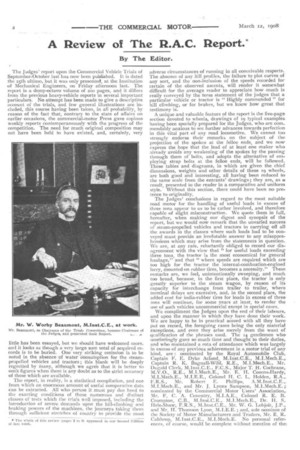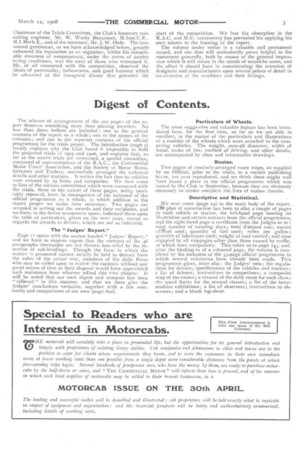A Review of The R.A.C. Report:
Page 2

Page 3

If you've noticed an error in this article please click here to report it so we can fix it.
By The Editor.
The Judges' report upon the Commercial Vehicle Trials of September-October last has now been published. It is dated the 25th ultimo, but it was only presented, at the Institution of Mechanical Engineers, on Friday afternoon last. The report is a derny-octavo volume of 200 pages, and it differs from the previous heavy-vehicle reports in several important particulars. No attempt has been made to give a descriptive account of the trials, and few general illustrations are included, this course having been taken, in all probability, by reason of the fact that, contrary to the state of affairs on earlier occasions, the commercial-motor Press gave copious weekly reports contemporaneously with the progress of the competition. The need for much original composition may not have been held to have existed, and, certainly, very little has been essayed, but we should have welcomed more, and it looks as though a very large sum total of acquired records is to be buried. One very striking omission is to be noted in the absence-of water" cOnstiMption for the steampropelled vehicles and tractors ; this blank will be deeply regretted by Many, although we agree that it is better to omit figures when there is any doubt as to the strict accuracy of those which are available.
The report, in reality, is a statistical compilation, and one from which an enormous amount of useful comparative data Can be extracted. All who peruse it must pay due heed to the exacting conditions of those numerous and distinct classes of tests which the trials well imposed, including the introduction of severe demands upon the hill-climbing and braking powers of the machines, the journeys taking them through sufficient stretches of country to provide the most adverse circumstances of running in all conceivable respects. The absence of any hill profiles, the failure to plot curves of any sort, and the non-inclusion of the speeds recorded for certain of the observed ascents, will render it somewhat difficult for the average reader to appreciate how much is really conveyed by the terse statement of the judges that a particular vehicle or tractor is " Highly commended " for hill climbing, or for brakes, but we know how great that testimony is.
A unique and valuable feature of the report is the five-page section devoted to wheels, drawings of 19 typical examples having been specially prepared for the Judges, who are come men dably anxious to see further advances towards perfection in this vital part of any road locomotive. We cannot to strongly endorse their remarks on the subject of theprojection of the spokes at the fence ends, and we now express the hope that the lead of at least one maker who already avoids any weakening of the spokes by the passing through them of bolts, and adopts the alternative of employing strap bolts at the felloe ends, will be followed_ These tables and diagrams, in which are given the chief dimensions, weights and other details of these 19 wheels, are both good and interesting, all having been reduced to the same scale from the entrants' drawings ; they are, as o* result, presented to the reader in a comparative and uniform style. Without this section, there could have been no pretence to originality.
The Judges' conclusions in regard to the most suitable road motor for the handling of useful loads in excess of three tons appear to us to be rather involved, and therefore capable of slight misconstruction. We quote theni in full, hereafter, when making our digest and synopsis of the report, but we would now remark that the unvaried success of steam-propelled vehicles and tractors in carrying off all the awards in the classes where such loads had to be conveyed must provide an irrefutable answer to any misapprehensions which may arise from the statements in question. We are, at any rate, reluctantly obliged to record our disagreement with the view that " for useful loads exceeding three tons, the tractor is the most economical for general haulage," and that " where speeds are required which are too high for the tractor the internal-combustion-engined lorry, mounted on rubber tires, becomes a necessity." These remarks are, we feel, unintentionally sweeping, and much too broad, because, in the first place, the tractor is only greatly superior to the steam wagon, by reason of its capacity for interchange from trailer to trailer, where terminal delays are excessive, and, in the second place, the added cost for india-rubber tires for loads in excess of three ions will continue, for some years at least, to render the use of such vehicles uncommercial except in special cases.
We compliment the Judges upon the end of their labours, and upon the manner in which they have done their work. We are happy to be in practical accord with all they haveput on record, the foregoing cases being the only material exceptions, and even they arise merely from the want of qealification of the phrases used. The 14 gentlemen who. unstintingly gave so much time and thought to their duties, and who maintained a rota of attendance which was largely in excess of any previous achievement in a motor trial of any kind, are : nominated by the Royal Automobile Club, Captain F. E. Dyke Acland, Captain R. K. Bagnall-Wild, R.E., M.I.Mlech.E., Mr. Degald Clerk, M.Inst.C.E., F.C.S., Major T. H. Cochrane; M.V.O., R.E., M.I.Mech.E., Mr. F. H. Cozens-Hardy, M.I.Mech.E., M.I.E.E., Colonel H. C. L. Holden,
F.R.S., Mr. Robert E. Phillips, A.M.Inst.C.E.,. M.I.Mech.E., and Mr. J. Lyons Sampson, M.I.Mech.E.; nominated by the Commercial Motor Users' Association,. Mr. F. C. A. Coventry, M.I.A.E„ Colonel R. E. B. Crompton, C.B., M.Inst.C.E., M.I.Mech.E., Dr. H. S. TIele-Shaw, F.R.S., M.Inst.C.E., Mr. W. G. Lobjoit, and Mr. H. Thomson Lyon, M.I.E.E. ; and, sole nominee of the Society of Motor Manufacturers and Traders, Mr. E. R. Calthrop, M.Inst.C,E., M.I.Mech.E. No personal refere ences, of course, would be complete without mention of the:
Chairman of the Trials Committee, the Club's honorary consuiting engineer, Mr. W. Worby Beaumont, M.Inst.C.E., M.I.Mech.E., and of the secretary, Mr. J. W. Orde. The lastnamed gentleman, as we have acknowledged before, greatly enhanced his reputation as an organiser, whilst his remarkable evenness of temperament, under the stress of sundry trying conditions, was the envy of those who witnessed it. He, of all connected with the competition, observed the ideals of punctuality, forbearance, and good humour which he advanced at the inaugural dinner that preceded the start of the competition. We fear his absorption in the R.A.C. and M.U. controversy has prevented his applying his own talents to the framing of the report. The volume under notice is a valuable and permanent record, and one that will undoubtedly prove helpful to the movement generally, both by reason of the general impression which it will create in the minds of would-be users, and the effect it should have in concentrating the attention dl designers and Manufacturers upon several points of detail in coustructkm of the machines and their fittings.


























